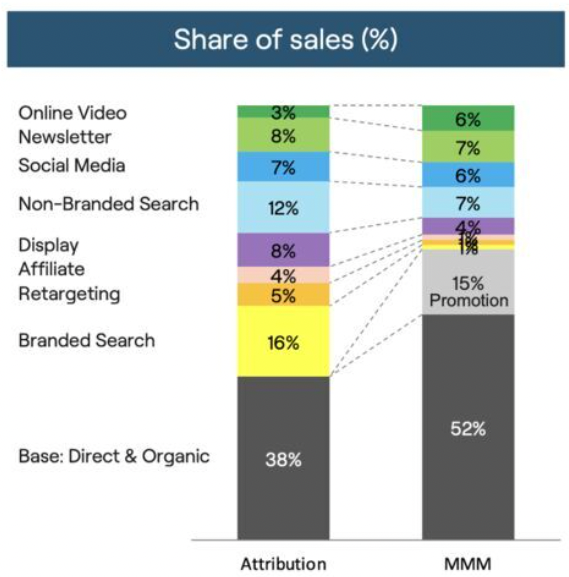Speak to any Chief Marketing Officer and they will say one of the most important aspects of the job is to determine, which elements of their marketing mix is actually delivering commercial value for their organisation. It’s an areas known as marketing effectiveness.
Despite the ambition this has been a historically challenging areas that can be neatly summarised by the quote from John Wanamaker:

Over a century later and the problem with marketing effectiveness persists on today for many organisations. Think about it, you release an advert on numerous channels, with multiple creatives and have a range of touch points with the consumer.
How do you know which elements are actually delivering you value and which are wasting your valuable resources?
Well, bring in two methodologies that can help unpick this; attribution and media mixed modelling.
So, what’s the difference?
Attribution is the process of identifying and assigning credit to the various touch points or marketing channels that contributed to a sale or conversion.
Media mix modeling is a statistical analysis technique that uses historical data to understand the effectiveness of different marketing channels, such as TV, digital, print, and social media, in driving business outcomes.
The goal is to identify which media channels and tactics are most effective at driving conversions and to optimise the media mix for the highest ROI.
The main difference between the two is that attribution focuses on understanding the specific role of each touchpoint in the conversion process, while media mix modeling focuses on understanding the overall effectiveness of different types of media in driving business outcomes.

Attribution modelling
Many guru’s pointed to digital media to be the first that could help paint a reliable picture. After all, you see an advert and click on it and then make a purchase. Ofcourse, it’s that advert that must have been the primary driver of your purchase decision, right?
Well, experience has now taught us that simple attribution models have series flaws. They will overestimate, the power of performance based advertising i.e. click here, buy now, whilst not accounting for the myriad of influences along the way before the click. This is pretty well recognised issue.
In addition, another watch-out of attrition modelling is that often we pull this data directly from platforms like Google or Meta Analytics, which only looks at the direct costs of the click, which represent a small proportion of overall costs to acquire a customer. Therefore, the level of incrementality is not considered.
Media mix modelling
For all these reasons, companies such as Google and Meta are moving towards more media mix modelling in order to gain a more balanced understanding of channel performance. This does have significant implications for marketers and how they understand their marketing effectiveness.

Let’s take an example from Sellforte where they analysed one of their customer’s share of sales % using the different methodologies. What we can see is a significant contrast between the models, where attribution over estimates marketing’s impact, relative to historical baseline activities.
In addition, we can see that certain channels such as Branded Search, Retargeting, Affiliate, Display and Non-Brand Search’s contribution are all over-estimated whilst areas such as Online Video are under-estimated.
You may think that I’m making the case for MMM, well in fact I’m not. Despite, it appearing that it’s a more accurate predictor of effectiveness it to suffers from some serious concerns.
- The first is that it’s highly historical and analyses things that have happened in some cases even a year ago.
- Secondly, you need a significant amount of (accurate) data to even begin the process of unpicking what happened.
- Thirdly, it also needs a significant amount of variance in the results – if things go smoothly, the results become less accurate.
So, which should you use?
Well, it depends on many factors, however I would say the most significant is the stage of your brand.
In the early stages, it’s unlikely you will have the resources, historical data and even the sophisticated channel mix, you will need to really deep dive into MMM. Rather you are better off using attribution modeling, while recognising and correcting for some of the bias this methodology will have.
On the other hand, if a brand is at the more mature end and runs a sophisticated marketing engine, it’s likely that using MMM will be a better option to provide a more accurate view on how the different channels are performing.


















